Data cleansing is an integral part of data enrichment.
Download our guide on data cleansing to find out more about maintaining data accuracy.
Data enrichment empowers data aggregators by infusing their datasets with valuable insights, thereby enhancing the overall quality, accuracy, and usability of the information. Our comprehensive guide explores its techniques, tools, best practices and the pivotal role it plays in data-driven decision-making.
Maintaining a clean, comprehensive, updated, enriched and accurate database is the lifeline of any B2B data aggregator. Advances in data enrichment techniques and tools for data verification and validation have made the job easier. But any data enrichment process can fail in reaching its aims without experts and a solid understanding of challenges and solutions.
Table of Contents
The data enrichment solutions market will reach USD 3.5 Billion by 2030, growing at 8.5% CAGR.
With the success of personalization and targeted data-based marketing, the demand for near real-time data enrichment has gone up. Amazon’s recommendation algorithm, Louis Vuitton’s “My LV” line, and Franklin Sports’ personalized product recommendations, all prove the case for data enrichment.
As a B2B data aggregator, you’ll already be using data enrichment tools and techniques. Our data enrichment guide will provide you with a handy collection of reference points to keep in mind when strategizing your data enrichment activities.
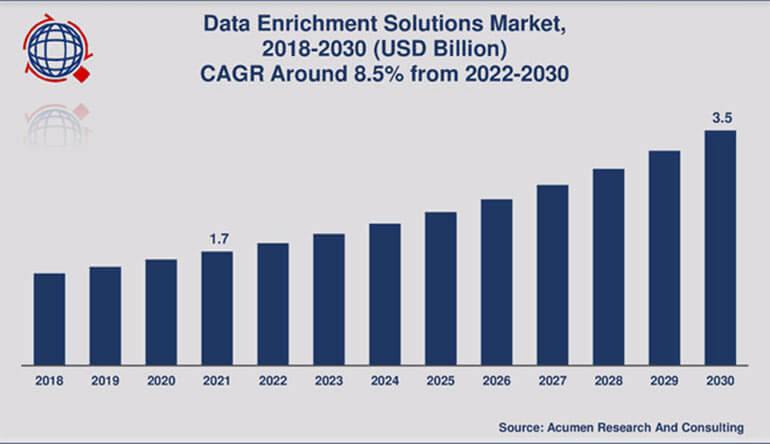
Incomplete or missing data can affect a dataset’s accuracy and usability. Some examples of common data gaps in B2B databases are –
Inaccurate or outdated data can dilute the effectiveness of sales & marketing and business decision-making. Some examples of inaccurate or outdated B2B data include –
Duplicate entries in B2B data can lead to confusion and inaccurate analysis. Some examples of duplicate entries in a B2B database include –
Inconsistencies and formatting issues can create data quality challenges, making it difficult to merge datasets and conduct effective marketing or sales campaigns. Some examples of inconsistent data in B2B databases include –
Data enrichment offers multiple benefits to B2B data sellers that can improve services, boost customer satisfaction, and increase sales opportunities.
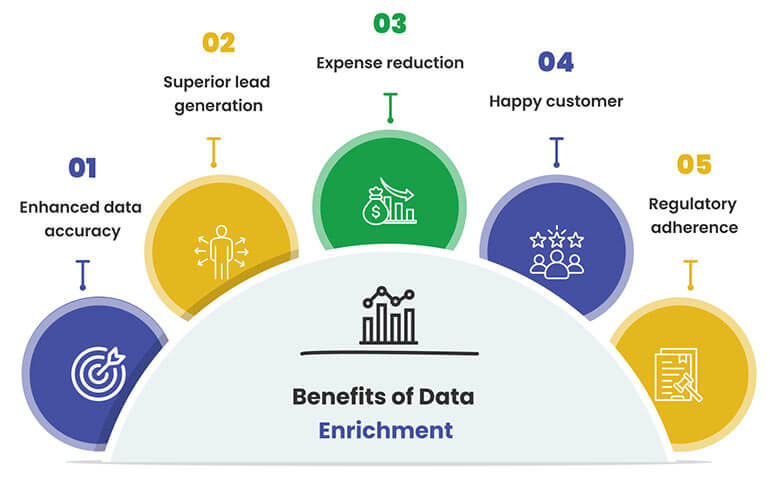
Better data quality: Data enrichment helps in data quality improvement in a big way by ensuring the accuracy, completeness, and reliability of the data. This makes their offerings more attractive and sellable.
Improved lead generation: Customer data enrichment helps the data sellers identify potential data buyers and remove incorrect data from their database. Data profiling and enrichment for financial advisory firm helped them win multiple bids to supply financial data.
Cost savings: Data quality improvement ultimately leads to enhanced database maintenance and hygiene leading to cost savings in multiple ways. Enriched data has fewer errors, and you spend less time and resources on data cleaning. Moreover, your marketing efforts are effective and targeted.
Customer satisfaction: By giving customers more information, data sellers can make their customers happier and even retain them. It’s often cheaper to keep people you already have than to get new ones. You even save on customer support costs as you get fewer complaints with enriched data.
Regulatory compliance: Data enrichment ensures that the data received from third-party sources complies with relevant regulations, reducing the risk of non-compliance related to data sources. This helps avoid any legal issues, penalties, and damage to their reputation.
Enrich your inaccurate data and make it actionable
Different types of data enrichment include
This kind of data enrichment adds insights that help in understanding audience demographics and helps in targeted marketing campaigns. Understanding the preferences of different customer groups helps in developing customized products and services. The data mostly includes –
Geographic data enrichment helps B2B companies identify new market opportunities by analyzing regional trends and patterns. It is critical for decision-making and creating strategies for various industries. It further assists businesses in predicting geographic patterns, creating targeted marketing campaigns, allocating resources, analyzing environmental impact, and visualizing complex data.
This covers location-based information, such as location, address, postal codes, etc.
This type of enrichment adds information about customers’ buying behavior, preferences, and interests, which helps businesses understand their customer’s needs and target them with relevant offers and promotions. Like the other B2B data types, it’s collected from public and private sources, using cookies to monitor web searches. This opens far more opportunities to approach prospects at exactly the right time in their buyer’s journey.
Common methods for collecting intent data include website tracking, social media monitoring, third-party data providers, surveys and feedback forms, and email marketing.
This type of data enrichment provides organizations with information about the applications their customers use, the operating systems they employ to access the application, and the devices customers employ to access the application. It includes information about customers’ app usage patterns, such as the apps they use, the frequency of usage, and the duration of usage.
This kind of data helps in evaluating the level of technology the person or the company uses and helps in accurate targeting.
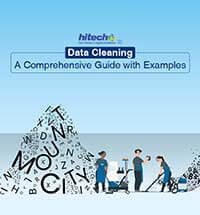
Data cleansing is an integral part of data enrichment.
Download our guide on data cleansing to find out more about maintaining data accuracy.
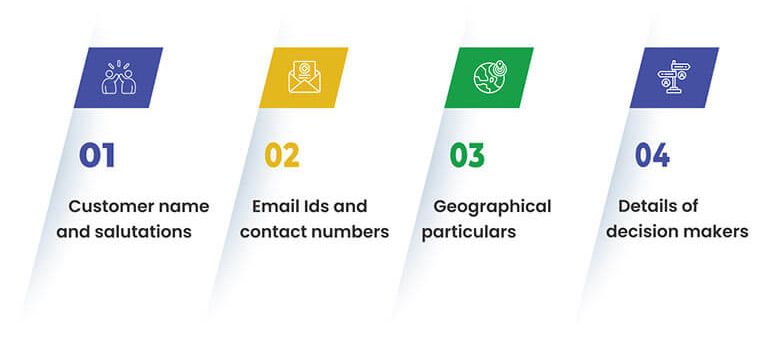
People often change names due to divorce, marriage, or personal reasons. And salutations also change accordingly. Some even have personal preferences to be called with certain salutations.
Personalization is the key to marketing data and any communication with an incorrect name or salutation can backfire and you may even lose the client permanently. People respond more positively to messages that address them by their actual name rather than a generic salutation. It also reflects your keen interest in reaching the client.
Incorrect or out-of-date email addresses can result in rejected emails, which can hurt your email deliverability rates. Additionally, high bounce rates can impact your reputation. Irrelevant emails can add to spam and lead to wasted time, effort, and cost.
Delivery failures, customer frustration about not receiving service or products, and additional costs in resending the items are some of the drawbacks of not having the correct address. It is extremely important to be careful and ensure address accuracy.
Incorrectly addressing communications to the wrong decision-maker harms credibility, causes missed sales opportunities, wastes resources, and results in diminished response rates. Precision in targeting the right authority is vital for effective and cost-efficient sales interactions.
CRM data enrichment is essential for database maintenance and hygiene. No B2B data seller can do without it. It is a complex process requiring the use of multiple techniques. We list out a few relevant techniques that will help keep your data accurate, enriched, and sellable.
This involves adding additional data to the existing data using various external sources. There are missing records, incomplete fields, say you have the address, but the email is missing, or the name of the decision maker. Plus, adding other data related to demographic, intent, geographic, and other such details need to be appended to the data to be able to draw meaningful insights from it. 150k profiles with accuracy added every month as an ongoing profile enrichment for a data aggregator keeping data validation as a constant process.
Data segmentation is a systematic procedure that involves partitioning a larger dataset into smaller, more distinct subsets or segments. This division is based on common attributes, such as demographics, behaviors, or preferences. This enables enterprises to employ targeted and customized marketing strategies, content, and messages to distinct audience segments, resulting in enhanced and personalized communication. For example, if a certain group of people enjoy vacations on hills the company can send messages to this audience on offers to visit hill stations.
In simple words derived attributes are data elements that are calculated or derived from existing attributes. They support analysis and decision-making by offering further data or insights based on already-existing characteristics. For example, ‘days until next birthday’ is calculated based on birthdate and current date. This helps in sending birthday promotions or the total sales for a customer or product is derived by summing up individual sales transactions.
This technique involves modifying or transforming the data to make it simpler to analyze and draw insights. The modifying process could include anything like sorting, filtering, aggregating, etc. For instance, filtering sales data for a particular month or converting currency values into a common unit are examples of data manipulation.
Entity extraction is a natural language processing (NLP) approach used to extract specific data from unstructured text data, including names of individuals, places, organizations, dates, and other entities. It helps transform text into structured data, facilitating information organization, classification, and analysis. Entity extraction helps to organize and make sense of unstructured text data in a variety of applications, such as chatbots, sentiment analysis, information retrieval, and data classification.
The practice of classifying and labeling data into predetermined groups or categories according to common traits or standards is known as data categorization. It aids in the effective storage, retrieval, and analysis of information by making data more manageable, searchable, and meaningful. This technique helps in data organization, classification, and better decision-making. A few examples would include when retailers categorize inventory by product type, brand, or size to streamline inventory control and restocking or when Websites categorize blog posts or articles by topics like technology, health, or travel, aiding navigation and content discovery.
The data enrichment process improves data quality and draws meaningful insights for better marketing and high conversions. However, the process has its own set of challenges that need to be addressed. Some of the challenges include:
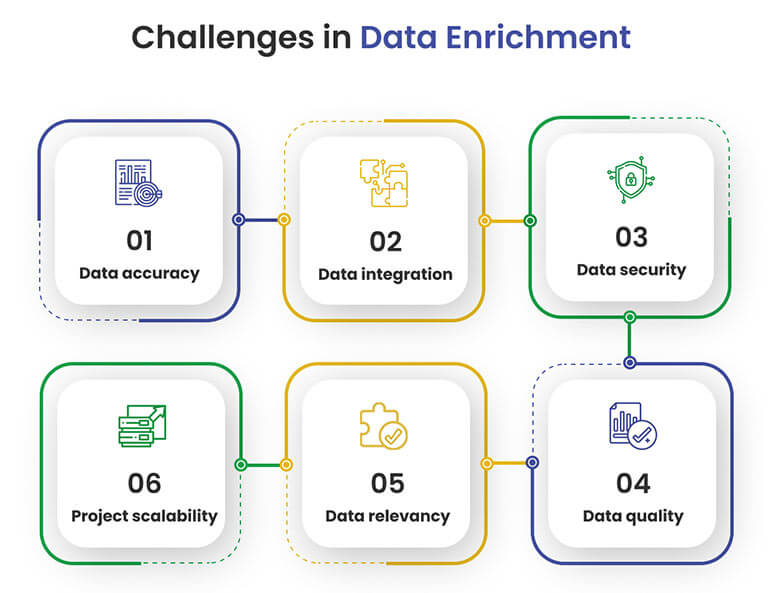
Here are some data enrichment best practices that can help improve the quality of your database:
Data enrichment is critical for improving data quality, depth, and usefulness across multiple domains in the data aggregation space. Here are some key industries that use data enrichment for better business growth.
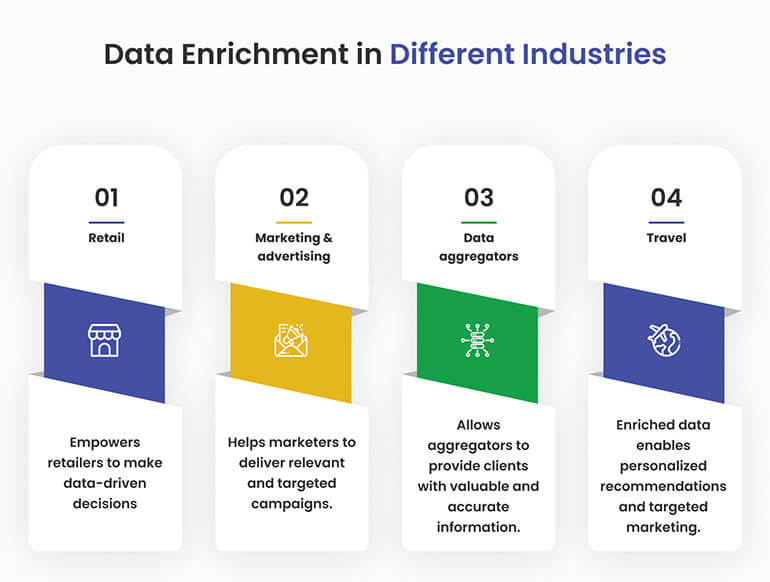
Data enrichment is a critical tool for the retail industry, enhancing customer experiences, operational efficiency, and sales. Retailers leverage data enrichment to create detailed customer profiles for personalized marketing, optimize inventory management, adjust pricing strategies, and monitor competitor pricing.
It aids supply chain optimization by incorporating real-time data on demand forecasts, supports location-based marketing, and enhances fraud detection. Enriched product data enables better product recommendations and market basket analysis, while trend analysis informs retailers about emerging market trends. Overall, data enrichment empowers retailers to make data-driven decisions, improve customer engagement, and remain competitive in a dynamic industry.
Data enrichment is a game-changer for the marketing and advertising industry, enhancing targeting and personalization efforts. Enriched data allows marketers to create detailed customer profiles, enabling precise segmentation for personalized content delivery and higher engagement. Lead scoring benefits B2B marketing by identifying promising prospects.
For ad campaigns, enriched data refines targeting, optimizing ad spend. Marketers use it for content personalization, A/B testing, and reducing customer churn. Data enrichment bolsters marketing analytics and supports competitive analysis. Overall, it empowers marketers to make data-driven decisions and deliver more relevant campaigns in the ever-evolving landscape.
Data enrichment is a great tool for data aggregators for enhancing the quality and depth of their datasets. It allows them to provide clients with more valuable and accurate information, increasing their competitiveness. Enrichment processes add additional attributes to datasets, enabling finer segmentation and customization to meet diverse client needs. This flexibility attracts a broader clientele and expands revenue potential.
Moreover, data validation and cleansing are inherent in enrichment, ensuring data reliability. Enriched data can be monetized at higher prices, opening new revenue streams. As industries increasingly rely on enriched data for decision-making, data aggregators are well-positioned to tap into these growing markets and opportunities.
Data enrichment transforms the travel industry by improving customer experience, operational efficiency, and competitiveness. Enriched data enables detailed customer profiling, facilitating personalized recommendations and targeted marketing campaigns.
Travel businesses optimize pricing strategies and inventory management, preventing overbooking and enhancing cost efficiency. Advanced recommendation engines offer tailored travel suggestions, while data aids logistics in optimizing routes and fuel efficiency. Fraud detection safeguards against booking scams.
Enriched data also informs market research, sentiment analysis, and destination marketing. It empowers travel insurance assessment and enhances safety with real-time alerts. In an ever-evolving industry, data enrichment ensures relevance, efficiency, and customer satisfaction.
Informatica Data Quality is a comprehensive data governance and quality management tool that ensures data accuracy, consistency, and reliability, facilitating data-driven decision-making and compliance with regulatory standards.
IBM InfoSphere QualityStage is a data quality and cleansing solution by IBM. It analyzes, standardizes, and cleanses data to enhance accuracy. It also offers data matching, deduplication, and address verification capabilities. Integrating with other IBM solutions, it’s crucial for maintaining high-quality data in industries like finance and healthcare.
Talend Data Quality is a data quality management tool offered by Talend, a leading data integration and data management software provider. It helps organizations improve the quality, accuracy, and reliability of their data. Key features include data profiling, cleansing, standardization, deduplication, and monitoring. Talend Data Quality ensures data complies with regulatory standards, enhances decision-making, and supports data governance initiatives. It can be integrated with other Talend products for comprehensive data management and integration solutions.
SAP Data Services is a comprehensive data integration and data quality tool provided by SAP, a global leader in enterprise software solutions. This platform enables organizations to extract, transform, and load (ETL) data from various sources, ensuring data accuracy and consistency. Key features include data profiling, cleansing, data enrichment, and real-time data integration. SAP Data Services is known for its ability to handle large volumes of data and support complex data transformations. It is widely used in data migration, data warehousing, and data governance projects to facilitate better decision-making and compliance with data quality standards.
Microsoft SQL Server Data Quality Services (DQS) is a data quality management tool integrated into SQL Server. It offers data profiling, cleansing, and enrichment capabilities, aiding organizations in maintaining accurate and reliable data. DQS supports reference data, matching, and integration with SQL Server Integration Services, making it valuable for data quality improvement and governance within SQL Server environments.
Clearbit is a data enrichment and business intelligence platform that provides organizations with a wide range of data-driven solutions. It offers APIs and integrations to help businesses enhance their customer data, enrich leads, and gain insights into companies and individuals. Clearbit’s data includes firmographic, technographic, and contact information, enabling businesses to personalize marketing, improve sales targeting, and streamline operations. It’s commonly used in sales, marketing, and customer relationship management to boost data quality and decision-making.
Dropcontact is a data enrichment and contact information retrieval platform. It assists businesses in enhancing their contact databases by automatically updating and enriching contact details, including names, email addresses, phone numbers, and more. Dropcontact uses web scraping and data verification techniques to ensure the accuracy and completeness of contact information. This service is valuable for sales and marketing teams looking to maintain up-to-date and reliable contact data for their outreach efforts, ultimately improving their efficiency and effectiveness.
ZoomInfo is a prominent B2B (business-to-business) contact and company database platform. It provides detailed information about companies and professionals, including contact details, job titles, company sizes, industries, and more. ZoomInfo is widely used by sales and marketing teams to find leads, perform market research, and enhance customer data. It offers features like lead generation, data enrichment, and lead scoring to support targeted marketing campaigns and sales prospecting efforts. ZoomInfo’s extensive database helps businesses identify potential customers and partners, making it a valuable tool for B2B lead generation and sales intelligence.
The choice between custom and proprietary tools for data enrichment depends on an organization’s unique needs, resources, and priorities. Custom tools offer greater flexibility and control but require significant development efforts, while proprietary tools provide ready-made solutions with less customization but may be faster to implement and come with vendor support.
Aspect |
Custom Tools |
Proprietary Tools |
|---|---|---|
| Customization | Highly customizable to specific business needs. | Limited customization options. |
| Cost | May have lower initial costs if developed in-house. | Often involve subscription fees or per-use charges. |
| Flexibility | Highly flexible and adaptable. | Less flexible. Users rely on updates and feature releases from the vendor. |
| Integration | Integration with existing systems can be seamless when designed correctly. | Integration may require additional effort and vendor support. |
| Ownership & Control | Full ownership and control over the tool’s development, maintenance, and data sources. | Limited ownership and control as the tool is owned and maintained by a third-party vendor. |
| Scalability | Can be scaled up or down as needed. | Designed to be scalable, but scalability options may vary by the tool. |
| Maintenance & Support | Requires internal teams to handle maintenance and support, which can be resource-intensive. | The vendor provides maintenance, updates, and customer support, often with service level agreements (SLAs). |
| Security | Security measures are customizable and can be tailored to meet specific security requirements | Proprietary tools often have built-in security features but may not be as customizable. |
Data enrichment adds context to missing or partial data from other sources. It can benefit businesses, however, there are ethical issues associated with this process:
Addressing these ethical considerations is crucial for maintaining trust and ensuring the responsible use of data enrichment techniques in various industries and applications.
The future of data enrichment is poised for significant transformation with several key trends shaping its landscape. Artificial Intelligence (AI) and Machine Learning (ML) will lead the change by automating processes, enhancing data accuracy, and uncovering valuable insights. Integration with CRM and Marketing Automation Platforms will streamline data management, enabling more precise targeting and improved customer engagement.
Real-time data enrichment will gain prominence, ensuring access to the latest information for timely decision-making. Data privacy and compliance will be paramount, with a focus on getting consent and secure data handling, in alignment with regulations like GDPR and CCPA.
Personalization and Account-Based Marketing (ABM) will drive the need for enriched data to tailor marketing strategies effectively. As businesses seek to maximize ROI and growth, data enrichment will play a pivotal role in delivering the insights necessary for personalized and targeted marketing efforts. These trends collectively signify a data enrichment landscape characterized by automation, compliance, and a relentless pursuit of data-driven success.
Data enrichment is important and should not be overlooked. It strengthens ties with customers, gives you the ability to make well-informed judgments, and powers the growth engines. Adopting strong data enrichment techniques is not only a choice but also a requirement if you want to succeed in today’s data-driven world.
Remember that expertise is your best ally in complex data enrichment. Collaborate with reputable service providers who are familiar with the complexities of data enrichment, compliance, and privacy. You not only protect the integrity of your data, but you also get a competitive advantage in your sector.
Data enrichment is the North Star directing you towards precision, success, and growth in the ever-changing field of B2B data aggregation. So, get going, enhance your data, and pave the route for a brighter, data-driven future. Your journey begins right now.
What’s next? Message us a brief description of your project.
Our experts will review and get back to you within one business day with free consultation for successful implementation.
Disclaimer:
HitechDigital Solutions LLP and Hitech BPO will never ask for money or commission to offer jobs or projects. In the event you are contacted by any person with job offer in our companies, please reach out to us at info@hitechbpo.com
Leave a Reply